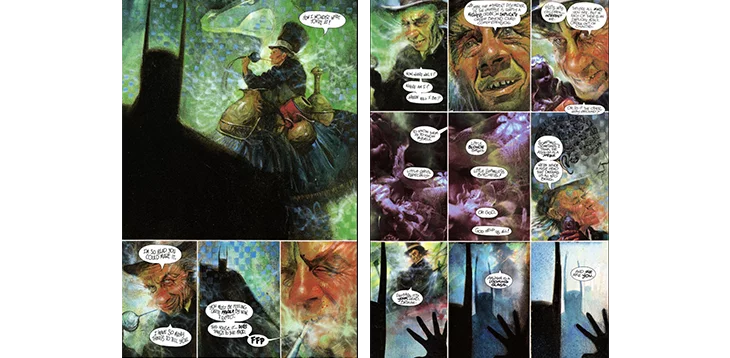How to write a graphic novel, from idea to publishing
Graphic novels and comic books have risen in popularity thanks in no small part to Hollywood adaptations. If you want to present your story visually, then how to write a graphic novel may be a question lurking through your mind.
There are some distinctions between a graphic novel and its more old and revered cousin, The Novel. The main one is that with graphic novels you get to tell the story visually. Sure, words can convey visually rich ideas. Literature is not short of classic examples such as Alice in Wonderland. But the scope of a graphic novel is to move past the boundaries of text and offer its readers a complete literary experience. So now you may ask, what is the difference between a graphic novel and a comic book? We’ll get to that shortly.
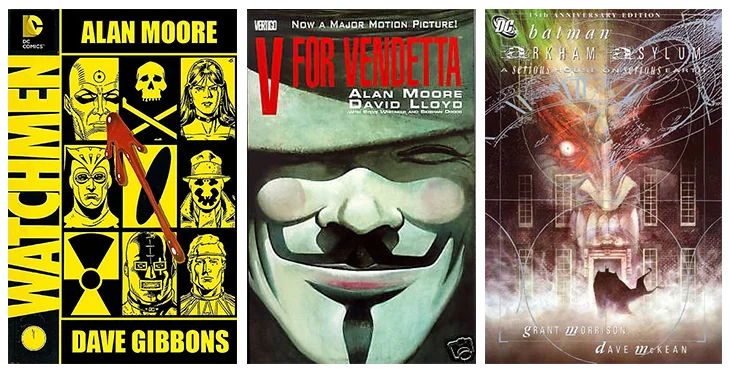
Images become a driving force for our retinas, while the text is more like a roadmap. Text is there to ease our interpretation of the drawing. Think of it this way. When asked by someone for directions, we visualize a path. We exclude all non-essential details and offer him a mental map.
This is the process behind every human representation. It’s also the process behind every graphic novel.
Both text and image are shadows of the same object, and in this regard should be equally considered.
Dealing with the process’s textual part, we’ll highlight the essential pillars that you must consider. Elements such as structuring, character motivations, conflict, symbolism, will all be discussed. In the end, you’ll want your craft to see the light of day. Luckily, we have a solution for that also. First, let’s see precisely what is a graphic novel, and what makes it unique.
What is a graphic novel?
The term graphic novel usually applies to a book formed out of comics content. Graphic novels are typically standalone stories, although, at times, they can be part of a series. The main thing to keep in mind when defining it is that it resembles the classical novel in terms of structure. Telling the story visually, via illustrations, is the thing that sets it apart.
The differences between comic books and graphic novels

Graphic novels depart from the classical novel format by adding comic strips to tell the story visually.
The question then is, what’s the difference between them and comic books?
- Graphic novels are more extended and tend to be more complicated than their comic book counterparts.
- Their resolve closely resembles that of a classic novel. Comic books are part of a larger whole, with each issue adding to the narrative.
- Graphic novels tell a complete story. Comic books are like pebbles pointing to a resolution. With each issue, you get a little closer. Whether it is a standalone work or a limited series, a graphic novel will take its reader through the whole journey.
The characteristics of a graphic novel
In terms of characteristics, they are the same as for the classical text-based novel. These include:
- A complete story. This means that your graphic novel will have a beginning, a middle part, and an ending. It basically follows the model of the Three Act Structure.
- Complex, tridimensional, characters.
- A main narrative, with underlying subplots developing along the way.
- Character development. Heroes or villains evolve in time, and as such, they go through personal journeys.
- Symbolism. Graphic novels aim at a theme, with symbols coming to enforce it.
We will talk about all of the above characteristics later on. They are the main pillars and requirements of every compelling graphic novel. Going on, we will trace a map for you, give you some hints of how to use them to create and move your story forward.
But before we get to that, let’s look at some classic examples in the field. When you are trying to figure out how to write a graphic novel, surely some names come to mind. We’ve compiled a list so that you have a starting point in your journey.
Classic examples
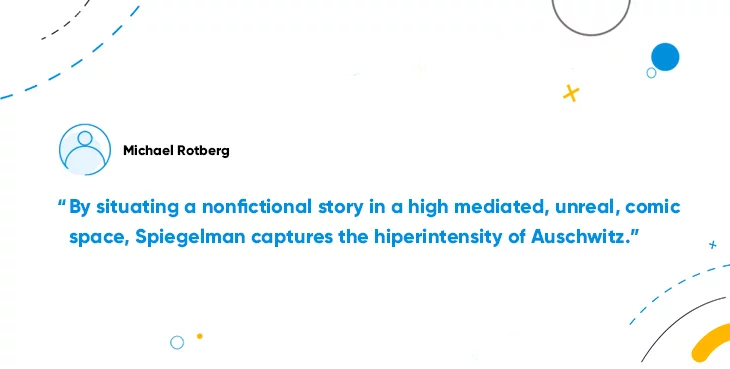
Graphic novels can range from superhero stories to autobiographical or historical ones. In this regard, they again share a similarity with text-based books. As we see, they can treat a wide array of subjects. History can be as compelling as any other work of fiction.
Classic examples of graphic novels
- Watchmen – Alan Moore and Dave Gibbons
- Batman, The Killing Joke – Alan Moore and Brian Bolland
- A contract with God – Will Eisner
- Maus – Art Spiegelman
- V for Vendetta – Alan Moore and David Lloyd
- Persepolis – Marjane Satrapi
- Arkham Asylum: A Serious House on Serious Earth – Grant Morrison and Dave McKean
- From Hell – Alan Moore and Eddie Campbell
- Violent Cases – Neil Gaiman and Dave McKean
- Drowned City: Hurricane Katrina & New Orleans – Don Brown
Figuring out your story
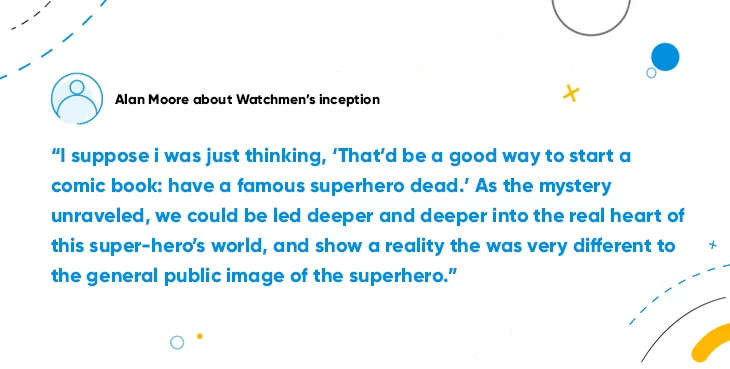
It sounds a bit redundant, but first, you must establish your story. What’s the main idea driving your narrative forwards? What is the underlying theme you wish to tackle? All elements in a graphic must communicate between them. Establishing your message first facilitates the construction of your characters, of your plot, and ultimately of your resolution. You can’t provide answers without first asking the questions. This is a logical fallacy that needs avoidance at all costs.
David Ogilvy pointed out that writing is a learning process. And as such, a good book requires exercise. This doesn’t mean the process is like trying to find Atlantis, a hidden key, or gem to elevate your artistic sensibility. Every subject can be a real subject! Whatever your topic may be, these are the things that need your consideration at all time:
Use symbols to add mystery
Symbolism must be thought of as your reader’s anchor to different worlds. Every great writer pays tribute to history. Symbols are there to enforce your idea. Don’t be afraid to use them. They can be powerful agents for conveying meaning.
Think about the clock in Watchmen for instance. It’s there to transmit a sense of urgency, of tension. Arkham Asylum is more than a mental hospital in Batman’s A Serious House on Serious Earth. It’s a visual representation of his own psyche. Swamp Thing is more than a creature, he’s a reminder that nature has a face and must be respected.
A note that you should keep in mind: Do not decipher your symbols! Don’t assume that your reader needs all the guidance. Have faith in his abilities. When we buy a puzzle, we don’t buy it to see someone else solving it. Let your reader pass through that fog, but be careful not to overcomplicate things. Symbols must not hinder your message. It must be furthered. To use an analogy, you are not creating a maze. You are creating multiple crossroads. Each road must point to the same destination but through different fields.
Given that we’re talking about how to write a graphic novel, you have a lot of freedom at your disposal. You can use symbols in your drawings as well as in your text, or even both. The choice is up to you.
The length of your text
Redundancy is an easy trap you can get caught in. The natural tendency is to operate with descriptions when writing a novel. Graphic novels, on the other hand, benefit from the presence of pictures. Too much text can diminish the impact of your designs. You don’t want them competing with each other.
Pay extra attention to brevity when developing your text. You don’t want words pouring over like rain on a wheat field. You want to tell your story mainly visually. Text is there to help the reader get a better sense of what’s going on with your characters.
Structuring your graphic novel
Although there are many ways to structure your work (you can check some of them here), one easy and effective method is to follow the Three Act Structure. It looks like this:
Exposition (inciting incident) -> Rising action (the midpoint) -> The climax (resolution)
You can read more about the Three Act Structure here.
Another, somewhat more precise way to go, would be to structure your narrative into five parts. Like this:
Exposition -> rising action -> climax -> falling action -> resolution
Both structuring methods speak the same language, so choosing one of them is completely up to you. If you need a clearer path of how your story should unfold, consider the second. If not, and the story is already fully engraved in your mind, you can choose to go with three acts.
Avoid loopholes

Loopholes are the bane of any writer’s existence. So we wanted to conclude this section with an emphasis on consistency.
Chekhov’s gun is a writing principle from the famous Russian playwright, stating that all elements comprising a story should be essential.
If we present our readers or audience with a gun, then at some point, that gun will need to be fired. The principle dictates that no element should be used simply as a false promise. False promises can produce inconsistencies.
And although inconsistencies may have their merit in provoking the reader’s curiosity, thread carefully not to induce a state of confusion with them. More often than not, inconsistencies translate to loopholes.
By the end, you should answer if not all, then at least the main question that you posed. In the example above, taken from Watchmen, we see that Ozymandias’ plan was, in the end, an exercise in futility. He prevented war by unleashing a calamity upon the world. We go full circle to The Comedian and finally understand his reasoning. All is a joke because in the end, nothing matters. Confronting human nature, you cannot prevent disaster. You can only delay it.
This brings us at the heart of every good piece of writing; the characters. How to write a graphic novel may be our primary concern, but characters ultimately carry the soul of the material. Let’s take a look at how to construct them.
Creating your characters
A great character echoes beyond any narrative. He is more than just a device, more than an amalgamation of traits and virtues. When thinking of Achilles, what’s the first thing that pops into our minds? It’s not that he was a great warrior, but his heel. He transgresses time and memory, being an incarnation of a symbol of an idea. Being more than a victim of hubris, he simultaneously is a direct incarnation of this foolish greek pride. The same applies to graphic novel characters as well.
The history of graphic novels and comic books abounds in great characters, so be sure to check some of them out.
If we are to discuss how to write a graphic novel, we must consider constructing a memorable character. Too often, writers fall victim to laziness. We do not want moral absolutes. They are not relatable to us. We need to see that our heroes have some flaws, that their evolution takes place not in the absence of difficulty, but despite it. Let’s cross a map of how a tridimensional character should look.
Motivations
You don’t want your characters wandering seamlessly into the world. You want them to have a history. An exciting event that ignites their actions and their reasoning. As humans, we act according to our view of the world. We are infused with judgments, preconceived notions, and reasons. We react to something. When writing your graphic novel, remember your characters must do the same. At least in the frames of their judgment, there always has to be something that justifies their actions.
V, from V for Vendetta, is not shy from committing morally reprehensible actions. The same can be said about Batman. V’s incentive is revenge, whereas a sense of justice governs Batman’s actions. Whatever the motive, be sure to add motivation behind your character’s decisions.
Conflict
Every good piece of literature is a stage for some form of conflict. Conflict is essentially tension. Tension between opposing worldviews, between one’s actions and their consequences and so on. It may come in multiple forms (we’ll get to that in a moment) but, for the time being, let’s note that conflict is necessary to keep your audience engaged. Opposing views give birth not only to action but to nuances as well.
When writing your graphic novel, try challenging your ideas. You want not only heroes but villains as well. You want contrasting and equal forces. They may appear on your pages, but their actual battlefront must be in your reader’s mind. Keep this in mind when figuring out the best type of conflict for your story. And this brings us at:
Types of conflict
Individual vs. Individual (or external conflict):
This is the most straightforward out of the whole bunch. It’s a character against a character like, for instance, Batman and Joker. The main thing to keep in mind if you’re going for this type of conflict, the villain must be as formidable as the hero. You want a challenging villain, one that makes the reader fear for the hero’s fate.
Hint: Build your main villain in an antithetical relationship with your hero.
Individual vs. Self (or internal conflict):
External conflicts take place in the world. Internal conflicts, on the other hand, represent a deep dive. In the depths of the human psyche lay the real monsters of creation. This is the birthplace of doubt, confusion, desire, and ultimately, evolution. Dr. Manhattan, Batman, V, every complex literary figure, confronts himself. When treating this type of conflict, remember that the world is a mirror reflecting your character’s thoughts.
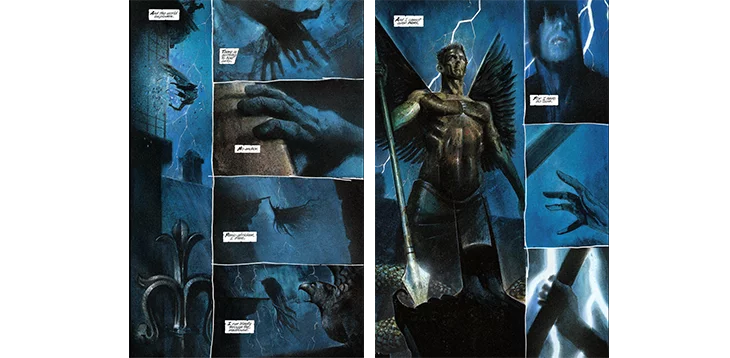
A Serious House on Serious Earth is a prime example of internal conflict. While navigating the horror infested corridors of Arkham Asylum, Batman confronts his own demons. Circling back to the beginning, this is a work of art full of symbolism.

Hint: Creating a graphic novel benefits from multiple types of conflict. When dealing with internal conflict, try adding a secret to your hero. Like in the case of Batman, this duplicity adds to the complexity of the character. He is both man and a symbol.
Individual vs. The World:
It may sound a bit abstract, but the world can refer to multiple things. It can mean nature, society, or some unknown pathogen or disease. One of the best examples that come to mind would be V for Vendetta. Here we have our hero facing a brutal society. His scope is revenge. His target is the system.
Hint: Try bringing your critique of different systems into play.

Values
Values and guiding principles are the backbones of your characters, and most likely then not, they are the ones sparkling the conflict. When you’re creating your graphic novel, make sure to delineate these characteristics.
Hint: Make these traits a product of character evolution. Show your readers an incentive, a driving force behind these principles.
Flaws
There is an inherent quality that goes into every complex character. They must be redeemable. Flaws are what make them human. Every action has its consequences and for this reason alone, errors in judgment should be allowed.

Hint: When talking about flaws, make sure you don’t overlook the aspect of memories. Memory is a fantastic medium for you to exploit the depth of your characters. If your hero remembers, he feels; by feeling, he cares; and if he cares, he is human.
Graphic novel adaptations
Before having their work adapted, all famous authors went through a long process of creation. Writing is an exercise, so be prepared to charge that pen or keyboard. Alan Moore, Neil Gaiman, Frank Miller, and many others, had immense success with their writing. Just remember the first came writing. And they wrote. They wrote a lot! Just take a look here at Gaiman’s writing process. Alan Moore began writing from the early 1970s. The first adaptation from his work came in 2001 with From Hell.
A lot of sweat and hard work go into coming with a masterpiece. You have to remain patient and have faith in your project. Maybe only a small fragment of what you write is any good. But that small fragment is enough to effectively make a difference. This applies to every form of art. There is a lot of trial and error involved. But in the end, if we take a look at some of these adaptations, we can see that Moore’s, McKean’s, Gaiman’s, and others, work was well worth the effort.
Hollywood is in part responsible for the growing popularity of graphic novels. Movies have done a fantastic job at offering a new perspective. Well, fantastic in most cases.
Cinematic adaptations
Although it seems like a longshot now, who knows. Maybe your graphic novel could someday make people argue around the internet. But before you strike gold, let’s take a look at some cinematic adaptations of our favorite graphic novels. How to write a graphic novel is one thing. How to translate it into cinematic language, is an altogether different beast. Although Alan Moore will surely disagree, Watchmen and V for Vendetta are beautifully shot cinematic representations of a book. Let’s take a look at some sample shots in comparison to their graphic counterparts:


And from Watchmen:
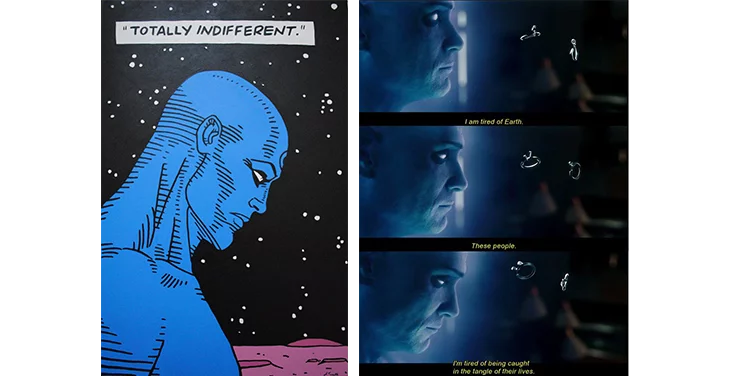
The world is turning to a more digitized approach. Graphic novels, as a form of art, go through the same process. Technology in art offers new perspectives and it can do the same with your graphic novel also.
And speaking of technology, let’s look at how to use our software to publish your work.
Publishing and selling with Flipsnack
Hopefully we managed to shed some light on how to write a graphic novel. It can be a convoluted process. You need magnificent artwork, an intriguing story and well rounded characters.
But if you follow the pillars highlighted above, we are truly confident that you will finally achieve your goals.
Next, now that you’re done with your craft, you would like for it to see the light of day. In the beginning, we promised that we’d offer you a solution for this. In the end, when trying to publish your material, usually you have to convince someone that your work is worthy. We already know this to be true. Using Flipsnack and taking full advantage of our Design Editor, you can publish your work by yourself.
Selling and promoting
By subscribing to Flipsnack’s Professional plan, you get to sell your masterpiece with a 0% fee from our part. Meanwhile, if you want to test the waters first, you also can embed your work on your website. Or you could share it on social media. It’s entirely up to you.
Simply upload your PDF and let our software do the rest.

In case you don’t have a finished PDF, but only the JPEG’s and text, don’t worry. Choose a panel display of your liking (below we’ve listed two examples, but there are many) and then start building it from scratch.
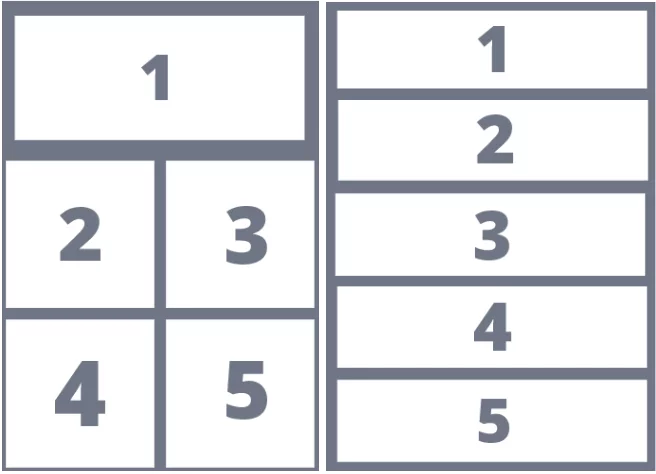
Just be careful, with great panel numbers comes great responsibility. The more panels you add to your page, the less space you’ll have for dialog boxes.
You’ll find all the necessary shapes in, you guessed it, the editor’s Shape section. Simply click on them and they will appear on your page. It shouldn’t be any harder than that, and with Flipsnack, it never will be!
Writing a graphic novel is now at hand’s reach. Go on and start publishing. The world needs to hear your story!








